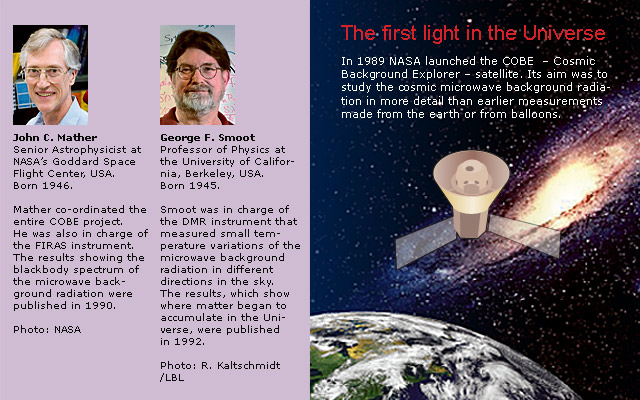The Nobel Prize in Physics for 2006 is awarded to John Mather and George Smoot. They have made measurements looking back into the infancy of the Universe and attempted to gain some understanding of the origin of galaxies and stars.
The Royal Swedish Academy of Sciences has decided to award the Nobel Prize in Physics for 2006 jointly to
John C. Mather, NASA Goddard Space Flight Center, Greenbelt, MD, USA, and
George F. Smoot, University of California, Berkeley, CA, USA
“for their discovery of the blackbody form and anisotropy of the cosmic microwave background radiation”.
Pictures of a newborn Universe
This year the physics prize is awarded for work that looks back into the infancy of the Universe and attempts to gain some understanding of the origin of galaxies and stars. It is based on measurements made with the help of the COBE satellite launched by NASA in 1989.
The COBE results provided increased support for the Big Bang scenario for the origin of the Universe, as this is the only scenario that predicts the kind of cosmic microwave background radiation measured by COBE. These measurements also marked the inception of cosmology as a precise science. It was not long before it was followed up, for instance by the WMAP satellite, which yielded even clearer images of the background radiation. Very soon the European Planck satellite will be launched in order to study the radiation in even greater detail.
According to the Big Bang scenario, the cosmic microwave background radiation is a relic of the earliest phase of the Universe. Immediately after the big bang itself, the Universe can be compared to a glowing “body” emitting radiation in which the distribution across different wavelengths depends solely on its temperature. The shape of the spectrum of this kind of radiation has a special form known as blackbody radiation. When it was emitted the temperature of the Universe was almost 3000 degrees Centigrade. Since then, according to the Big Bang scenario, the radiation has gradually cooled as the Universe has expanded. The background radiation we can measure today corresponds to a temperature that is barely 2.7 degrees above absolute zero. The Laureates were able to calculate this temperature thanks to the blackbody spectrum revealed by the COBE measurements.
COBE also had the task of seeking small variations of temperature in different directions (which is what the term ‘anisotropy’ refers to). Extremely small differences of this kind in the temperature of the cosmic background radiation – in the range of a hundred-thousandth of a degree – offer an important clue to how the galaxies came into being. The variations in temperature show us how the matter in the Universe began to “aggregate”. This was necessary if the galaxies, stars and ultimately life like us were to be able to develop. Without this mechanism matter would have taken a completely different form, spread evenly throughout the Universe.
COBE was launched using its own rocket on 18 November 1989. The first results were received after nine minutes of observations: COBE had registered a perfect blackbody spectrum. When the curve was later shown at an astronomy conference the results received a standing ovation.
The success of COBE was the outcome of prodigious team work involving more than 1,000 researchers, engineers and other participants. John Mather coordinated the entire process and also had primary responsibility for the experiment that revealed the blackbody form of the microwave background radiation measured by COBE. George Smoot had main responsibility for measuring the small variations in the temperature of the radiation.
John C. Mather, born 1946 (60), (US citizen). PhD in physics in 1974 from University of California at Berkeley, CA, USA. Senior Astrophysicist at NASA Goddard Space Flight Center, Greenbelt, MD, USA.
George F. Smoot, born 1945 (61) in Yukon, FL, USA, (US citizen). PhD in Physics in 1970 from MIT, Cambridge, MA, USA. Professor of Physics at University of California, Berkeley, CA, USA.
Prize amount: SEK 10 million to be shared equally between the Laureates.
